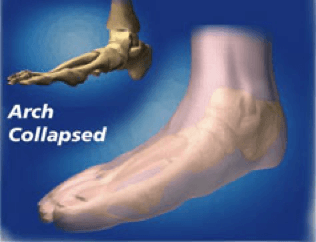The whole world has heard of arch supports, custom insoles or orthotics. They are as common as sliced bread or canned soup. And most of them are fairly worthless. Why?
The foot is actually a complex machine that depends on all of its 26 bones and even more joints to work in harmony. When it works as designed, the foot is capable of remarkable things which all help insure not only pain-free health of the foot, but the parts up the chain, including ankles, knees, hips and spine. The foot unwinds to absorb shock as the heel strikes the ground, changes shape to accommodate to varied terrain, then winds back up to be a firm, propulsive lever to advance forward.
There are two basic states of the foot that should be very familiar: arch up and arch down. The arch down state happens when, after the heel strikes the ground, the foot unwinds inside and the arch does a free fall due to gravity. Most people are able to do this so well they overdo it. More on this later.
The arch up state comes next, because that is what makes the foot a rigid lever for push off. The foot must wind back up inside to raise the arch and stiffen itself. If the arch stays down you have to propel yourself forward with a mushy foot. That is not only tiring because your muscles have to work harder, it leads to the common foot pains and deformities that afflict millions every day: bunion, plantar fasciitis, and metatarsalgia to name a few.
The arch down state is important to absorb shock and adjust to uneven floor surfaces. But when it is overdone, the arch can’t get back up. Going down hill is easy, but how does it get back up, into the arch up state? About 90% of the population can’t get back up enough to have normal foot function. Assisted by gravity, body weight, muscle weakness and hard floors, the foot learns to unwind and flatten the arch ever closer to the ground, getting flatter with age. You may have heard this called over-pronation, which is just a fancy name for flat, flexible feet.


From a very common-sense, mechanical point of view, the only way you can effectively control the foot is to apply a force directly up under the arch. The reason we can now do that comfortably is modern plastics. The goal is to create a custom, supportive platform for each foot that is rigid enough to achieve the arch up state, yet flexible enough to allow some small degree of flattening for shock absorption, terrain adaptation and comfort. To do that we have to know how much a person weighs, because bigger people need more support.

But before we can make a truly custom device, we have to cast your feet in a very specific way in order to capture the corrected position we want the orthotic to impose on your foot. If you just stepped in a box of foam, we would capture all that is wrong about your feet: the fallen arch, the splayed forefoot, etc. That is why your provider was carefully trained in our casting technique and why we only accept orders from providers trained in our techniques.
No one makes orthotics like Sole Supports does. It costs more to make them, we have to reject casts that are not done well enough, we only take orders from providers who have had their training and they have to do their work carefully and thoroughly in order for you to be comfortable. But the good news is, once they have bothered to do all that, we have created an orthotic that really works the way it is supposed to. We actually change how a foot functions on the ground.

So what’s the big deal? Well . . . ask someone who really suffers from persistent foot pain or a deformity that keeps rubbing into their shoes. Or ask someone who has just had their third surgery to correct a bad bunion. Or someone who is off work because their plantar fasciitis is so bad they can’t stand or walk for more than 10 minutes at a time. The fact is, many people suffer from foot disorders and are constantly looking, sometimes desperately, for relief.
There are many routine treatments for foot problems, from anti-inflammatory pills to cortisone injections, to a zillion different pads, cushions, ointments and, of course, surgery. All of these have temporary, pain-relieving effects. But, if you want the chance to permanently solve the problem, you must change the way your feet function on the ground. And the only way to do that is to use a true custom, biomechanical orthotic: Sole Supports.
Imua Physical Therapy is proud to offer this great product. Contact us to schedule your orthotic casting!
